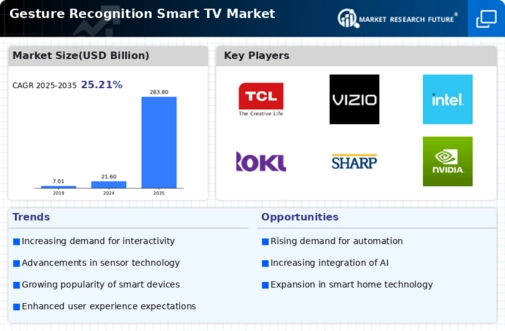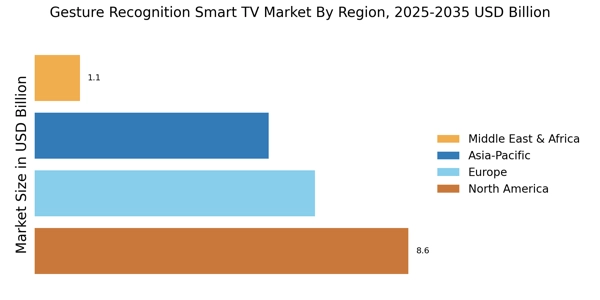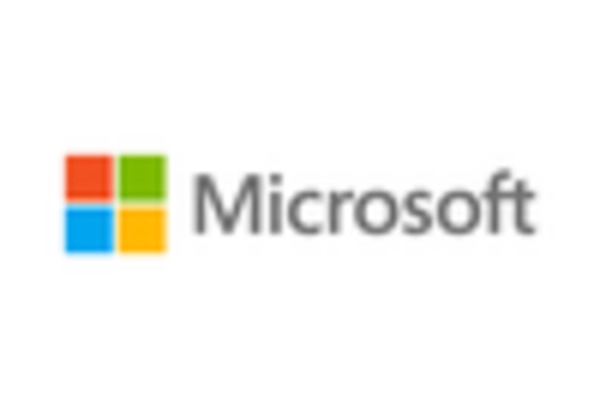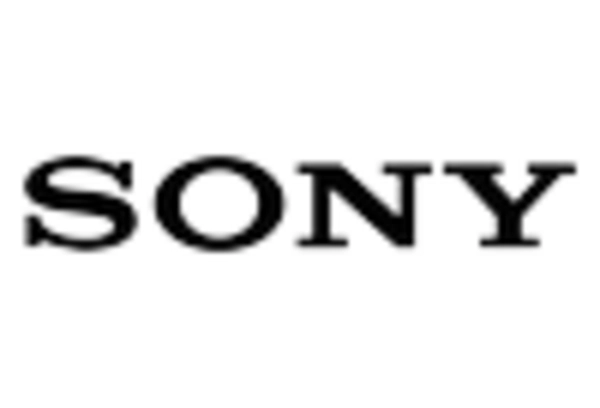The Gesture Recognition Smart TV Market is currently characterized by a dynamic competitive landscape, driven by rapid technological advancements and evolving consumer preferences. Major players such as Samsung Electronics (KR), LG Electronics (KR), and Sony Corporation (JP) are at the forefront, each adopting distinct strategies to enhance their market positioning. Samsung Electronics (KR) emphasizes innovation through its advanced gesture recognition technology, which integrates seamlessly with its Smart TV ecosystem. Meanwhile, LG Electronics (KR) focuses on regional expansion, particularly in emerging markets, to capture a broader audience. Sony Corporation (JP) appears to be leveraging partnerships with content providers to enhance user experience, thereby solidifying its competitive edge. Collectively, these strategies contribute to a competitive environment that is increasingly centered around technological differentiation and user engagement.
In terms of business tactics, companies are localizing manufacturing and optimizing supply chains to enhance efficiency and reduce costs. The market structure is moderately fragmented, with several key players exerting considerable influence. This fragmentation allows for a variety of consumer choices, while also fostering innovation as companies strive to differentiate their offerings. The collective influence of these key players shapes the market dynamics, pushing for continuous improvement in gesture recognition technologies and user interfaces.
In August 2025, Samsung Electronics (KR) announced the launch of its latest Smart TV model featuring enhanced gesture recognition capabilities, which allows users to control their devices with simple hand movements. This strategic move not only showcases Samsung's commitment to innovation but also positions the company to capture a larger share of the market by appealing to tech-savvy consumers seeking intuitive user experiences. The introduction of this model is likely to set a new benchmark for competitors in the gesture recognition space.
In September 2025, LG Electronics (KR) entered into a strategic partnership with a leading AI firm to develop next-generation gesture recognition algorithms. This collaboration aims to improve the accuracy and responsiveness of gesture controls in their Smart TVs. By aligning with an AI specialist, LG is not only enhancing its product offerings but also reinforcing its commitment to integrating cutting-edge technology into its devices. This partnership could potentially lead to a significant competitive advantage in the rapidly evolving market.
In October 2025, Sony Corporation (JP) unveiled a new software update for its Smart TVs that incorporates advanced gesture recognition features, allowing for more personalized user interactions. This update reflects Sony's ongoing investment in software development and user experience enhancement. By continuously improving its technology, Sony is likely to maintain its relevance in a market that increasingly values user-centric innovations.
As of October 2025, current competitive trends in the Gesture Recognition Smart TV Market are heavily influenced by digitalization, sustainability, and the integration of artificial intelligence. Strategic alliances are becoming increasingly pivotal, as companies recognize the need to collaborate to stay ahead in a rapidly changing landscape. Looking forward, competitive differentiation is expected to evolve, shifting from traditional price-based competition to a focus on innovation, technological advancements, and supply chain reliability. This transition underscores the importance of not only meeting consumer demands but also anticipating future trends in technology and user experience.

















Leave a Comment